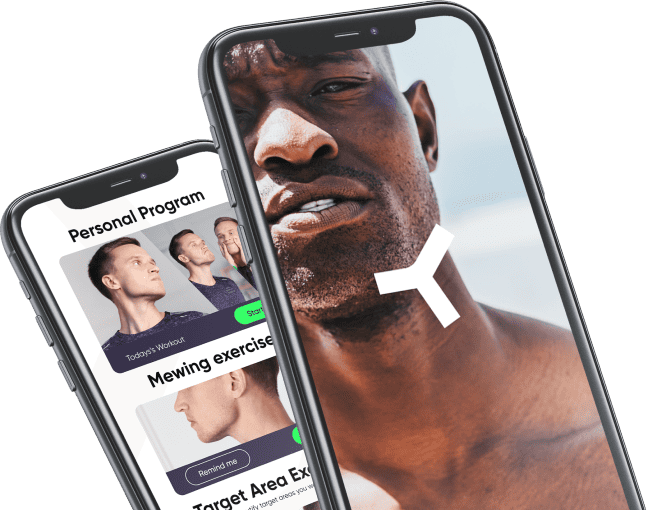Facial expressions convey emotion, and this form of nonverbal expression can overcome both social and cultural differences and connect with others. Darwin has also studied the importance of expressing emotions and ideas by using the face, concluding that facial movement finds its origins in the evolution of the human species.
Face exercises activate the facial muscles and allow individuals to perform facial expression that portrays their inner state accurately. Consequently, by understanding how facial muscles work, you’ll be able to understand the emotion behind the facial expressions of others.
Thus, in this article, we’ll explore:
- 😄 The seven different expressions on the face
- 📋 The benefits of facial exercises and the top techniques for practicing them.
Let’s get started!

The 7 Universal Facial Expressions
According to the FBI Law Enforcement Bulletin, there are 7 facial expressions, regardless of gender or race. The following provide insight into a person’s internal emotional state and are common to all without exception:
- Anger
- Happiness
- Contempt
- Disgust
- Fear
- Surprise
- Sadness
Although Darwin was the first to point out their significance, since then, plenty of further research has been conducted. Psychologists have taken a great interest in how emotion displays in everyday behavior, which has led to numerous studies.
Studying facial muscles and their movement, researchers have found that nonverbal language is more complex than we imagined. Going into greater detail about what exactly determines an expression, they’ve identified what the movements of individual facial features signal:
- Eyebrows. Raised eyebrows signal surprise, frowned ones signify anger, while raised inner corners of the eyebrows imply sadness.
- Lips. Pursed lips are a sign of contempt, smiling signals joy, while frowning depicts sadness and anger.
- Eyes. An intensely focused gaze is a sign of anger or fear, while when someone has their eyes wide open, that person is experiencing either fear or surprise.
Benefits of Facial Expression Exercises
Activating all the muscles of the face comes with an array of advantages that help improve aspects of physical health, including aiding facial skin and increasing facial blood circulation.
However, this also helps positively affect mental well-being:
Improved Communication Skills
As we already mentioned, your nonverbal signals, which incorporate both facial expressions and body movements, determine how other people perceive you and vice versa. Researchers found that being able to read the facial expressions of others helps identify how they feel. This skill may be of great benefit to professionals such as educators, healthcare personnel, and every businessperson, no matter their industry, but applying it to everyday life may be of great benefit as well.
People often try to hide their emotions or are not very adept at expressing them through words, meaning that understanding what even the smallest movement of facial muscles signifies can help you manage the situation and articulate your response to receiving positive feedback.
Enhanced Emotional Intelligence
Being able to spot and identify a given facial expression and determine the emotional state of another person is a valuable skill. However, not all expressions are apparent and easily noticeable. If you pay close attention while talking to another person, you may notice that some expressions are so minor it only takes a second for them to go away.
These expressions are known as micro-expressions and are considered to be the most genuine, as we have little to no control over them. Micro-expressions can help you see if a person is being truthful or lying and offer a glimpse into their inner world.
Note: Individuals that suffer from conditions such as SAD have difficulty reading people’s facial expressions, and performing facial exercises can help enhance their understanding of others.
Increased Facial Muscle Tone and Elasticity
During recent years, facial yoga has received much acclaim due to its many benefits. It’s popularized as an effective way to reduce the amount of skin under the chin by eliminating sagging.
In addition to the reduction of the appearance of fine lines, facial yoga may also lead to lymphatic drainage, improved blood circulation, and reduced puffiness in facial skin. Overall, facial exercises are often seen as exercises that can help tone the face, and with good reason.
Reports also suggest that when put into practice, facial yoga helps practitioners learn how to relax and strengthen certain muscles, which can lead to a better posture, reduced teeth grinding, and eliminated sleeping problems relax.
Reduced Stress and Anxiety
Stress and anxiety are known to have an effect on both the physical and mental state. Experiencing tension and pain in all the muscles is a common symptom of anxiety, and prolonged stress can often be stored in the neck muscles.
Regular facial exercises can help better your mood and decrease levels of stress. Though further studies on the benefits of facial exercises are needed, it is evident that facial exercises can aid mental well-being and improve depressive symptoms.
Improved Mental Health
Exercise is known as a way to improve both physical and cognitive conditions, and this is true for children and adults alike. One category of adults is in direst need of exercise, and this is the elderly population. Researchers studied the effects of facial exercise in a group of adults older than 60 and found that facial exercises can help strengthen the tongue, improve facial expression, and ensure better mental health.
Increased Self-awareness
It is a part of an actor’s job to build a connection with the audience and elicit emotions from them, but to do so, an actor must have total control over facial expressions. This requires actors to have a high degree of self-awareness combined with the ability to speak through smiles or only by moving their eyelids.
An actor must master control over the facial muscles, and this can be done only through exercise. If we take a closer look into acting facial expressions exercises, we’ll find that these are aimed at relieving tension from the face and relaxing cheek muscles.
What Causes Lack of Facial Expression?
A lack of facial expression is usually the result of a flat affect. We can define this as a condition in which people don’t express emotion the same way as others. However, flat affect is not a condition or a disorder, it is a symptom of other conditions.
Individuals dealing with flat affect can show the following symptoms:
- Monotonous speaking voice
- Avoidance of eye contact with others
- Appearance of apathy
- A “blank,” a.k.a. emotionless face.
What usually contributes to the lack of emotion in their expression is a muscle disorder, facial paralysis, or, in some cases, medications.
Can you Train Your Facial Expression?
Yes, facial expressions can be learned through exercise, even by performing facial exercises lying down. Doing face exercises can help you have better control over your facial muscles and give you overall control over your expression and appearance.
Techniques for Practicing Facial Expression Exercises
Let’s look at the top exercise ideas for facial exercise:
Mewing
Mewing is all about proper tongue posture. Overall, mewing aims to improve the whole symmetry of the face. It can also help you adopt one of the female jawline types that are considered the most attractive.
By learning the correct mewing tongue position, you will experience many benefits, including:
- A stronger jaw
- Better jaw movement
- Well-toned neck
- Improved profile look
- Healthier mouth and more perky lips
- More accentuated cheeks and nose
- Stronger face muscles.Whether you wish to incorporate mewing into your daily life to gain better control over your face muscles or use it simply as a jaw exercise, you will find that the mewing benefits list is quite long.
Try the Mewing.coach app
As part of this mewing 101 introduction, we must mention that you don’t have to do the work on your own and scroll through thousands of articles and tutorials just to learn the basics. You can simply download our Mewing.coach app and enjoy:
- Daily mewing reminders
- Tailored exercise plan
- Video tutorials of difficult exercises.
Mirror exercises
For the best results when doing facial exercises, you might like to try sitting in front of a mirror. This gives you the opportunity to observe your facial expressions and become more self-aware.
Give attention to Your Eyebrows
Alien movie fans can confirm that without the eyebrows, people very much resemble outlanders. The position of our eyebrows largely determines our expression, and this exercise will help you make a note of that.
Press two fingers under each eyebrow and push upwards. Try lowering your eyebrow without changing the pressure and hold for a few seconds. Repeat this around 15 to 20 times.
Role-playing Exercises
Reflection is one of the most common facial expression exercises for actors. For this to work, you will need to face your partner head-on and try to get inside their head. Observe their movements closely and mirror their face expression.
Visualization Techniques
Visualization techniques operate subconsciously, build internal motivation, and program your brain to achieve the desired outcome.
You can use this to your own advantage and try visualizing different expressions just to see what emotions mean to you and how you see them. Though this is not a technique that directly targets muscles, it helps guide your way through other aspects related to face exercises.
Facial Pilates
In addition to facial expression exercises, Pilates offers a holistic approach to improving facial muscle tone and overall well-being. Pilates exercises focus on core strength, flexibility, and body awareness, which can indirectly benefit facial expressions by promoting overall physical health and posture.
Many Pilates exercises engage the core muscles, including those in the abdomen, back, and pelvis, which can contribute to better posture and alignment. Improved posture can enhance confidence and presence, allowing individuals to convey emotions more effectively through their body language and facial expressions.
Gesture and Posture Exercises
The expressions you have on your face do not exist individually without connection to other body parts. A head facing forward and double chins are some factors that influence jaw movement, which also determines your ability to correctly articulate your emotions.
Facial yoga is not the only exercise you need in your life. Including other exercises, such as chest openers, the child pose, and the standing cat cow, will improve your posture and aid overall health.
Lion Face Exercise
The Lion Face exercise is one that aims to stretch your facial muscles as much as possible. It involves standing in front of a mirror and opening your mouth as wide as possible, just as a lion would. Then scrunch your face as small as possible.
This will not only stretch the muscles, but it will also help relieve tension. Many people like to think of it as making an impression of Edvard Munch’s Scream!
Cheek Lifts
The cheek lift exercise is very popular within the anti-aging facial yoga community, and with good reason. Practicing facial yoga regularly can significantly alter skin appearance.
For the Cheek Lifter exercise, you need to open your mouth and form an “O” shape, then pull the upper lip over the top teeth and smile to lift the cheek muscles. Next, put your index fingers on top of your cheeks and release the muscles to lower them and lift them back up.
Strengthening facial muscles and reducing fine lines are not the only benefits this exercise offers – it also makes a great choice for individuals looking to get rid of the cheek fat that’s been bothering them.
The Most Common Mistakes to Avoid when Practicing Facial Expression Exercises
While facial exercises can be beneficial in many ways, there are a few things worth keeping in mind:
Overdoing It
There is always a reason behind the recommendations on how many times you should repeat a given exercise. Going off script and improvising can be a good idea in many situations but not in this one, so make sure to play by the rules,
Focusing Too Much on One Expression
Each exercise is designed to target a specific muscle group, and targeting only a given group while neglecting others will not lead to favorable results. This is why it is best to incorporate various exercises into your face routine.
Not Paying Attention to Muscle Use
As we mentioned earlier, facial exercises are also here to help us become more aware. Repeating the movements can be of benefit, but this will not result in conscious control over your facial muscles.
Forgetting to Relax
One of the most common mistakes that people who do forehead exercises make is that they forget to relax. This is a common reason why many report that facial yoga is a hoax and the wrinkles are still there after months of practice.
Not Practicing Regularly
As with any other form of exercise, practice makes perfect, and regular facial exercises can give you the results you are looking for. Of course, that’ll only happen with a little time and patience included.
Not Seeking Guidance
Last but not least, every student needs a teacher. While learning things through self-discovery might be satisfying, reaching out for help will make this journey easier.
Blitz Answers
How To Control Facial Expressions
You can control your facial expressions by practicing different looks in front of a mirror and paying attention to how your face feels when you’re feeling different emotions. With practice, you can learn to manage your facial expressions better.
Facial Expression Exercises For Actors
Actors do exercises to strengthen and flex their facial muscles, helping them express emotions better on stage or in movies. They practice making different expressions in front of a mirror and exaggerating them to improve their acting skills.
How To Improve Facial Expressions While Talking
To improve your facial expressions while talking, pay attention to matching your expressions with your emotions. Practice in front of a mirror to see what expressions you’re making and work on adjusting them to fit what you’re saying. Watching videos of yourself can also help you see how you can improve.
Conclusion
Face exercises can help you gain control over your appearance, get a better understanding of others, and positively affect your communication skills. Advantages such as physical and mental health improvements are also on the table, making exercising a great option for anyone looking to improve the persona they display in front of the world!



